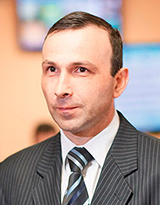Features of the Crystal Structure and Magnetic Characteristics of the Solid Solutions Ni1–xMxMnSb (M = Fe, Co) Systems
https://doi.org/10.35596/1729-7648-2022-20-8-5-13
Abstract
The results of studying the effect on the crystal structure and magnetic properties of compounds based on NiMnSb when Ni cations are replaced by Fe and Co cations are presented. The solid solution Ni1–xMxMnSb (M = Fe, Co) systems were synthesized by the method of solid-phase reactions. With the help of X-ray diffraction analysis, the presence of a concentration structural transition was established. Using the ponderomotive method, it was found that the temperatures of the “magnetic order – magnetic disorder” phase transformation decrease as nickel is replaced by iron and cobalt. The field dependences of the specific magnetization demonstrate the typical behavior of a magnetically soft ferromagnet. The results of an experiment on the study of the crystal and magnetic structure of solid solutions of the Ni0.90M0.10MnSb (M = Fe, Co) systems using thermal neutron diffraction in the temperature range of ~(3–300) K are presented. It is found that the studied compositions exhibit ferromagnetic ordering along the c axis. On the spectra of Ni0.90Co0.10MnSb solid solutions in the region of 2Θ = 28.6° the appearance of a reflection indicating the formation of antiferromagnetic ordering is observed. Within the framework of the density functional theory, an ab initio calculation of the magnetic moments for Ni1-xMxMnSb (M = Fe, Co; x = 0; 0.125; 0.250) was carried out. The results of theoretical calculations predict the existence of magnetic moments for Fe and Co ions, and they are antiferromagnetically coupled to the spins of Mn and Ni ions.
Keywords
About the Authors
G. S. RymskiBelarus
Rymski G. S., Researcher at the Laboratory of Physics of Magnetic Materials
220072, Minsk, P. Brovka St., 19
Tel. +375 17 378-12-38
V. M. Fedosyuk
Belarus
Fedosyuk V. M., Corr. Member of the National Academy of Sciences of Belarus, Dr. of Sci. (Phys. and Math.), General Director of Scientific-Practical Materials Research Center
Minsk
A. V. Rutkauskas
Russian Federation
Rutkauskas A. V., Cand. of Sci., Researcher at Frank Laboratory of Neutron Physics of the Joint Institute for Nuclear Research
Dubna
E. V. Duzeva-Maltseva
Russian Federation
Duzeva-Maltseva E. V., Research Laboratory Assistant at the Department of Neutron Experimental Facilities
Moscow
A. T. Tuan
Viet Nam
Tuan Anh Tran, Dr. of Sci. (Eng.) of Applied Sciences Faculty
Ho Chi Minh
T. D. Ngoc
Viet Nam
Ngoc Toan Dang, Dr. of Sci. (Phys. and Math.) of the Faculty of Environmental and Natural Sciences
Danang
References
1. Hirohata A., Yamada K., Nakatani Y., Prejbeanu I.-L., Dieny B., Pirro P., Hillebrands B. (2020) Review on Spintronics: Principles and Device Applications. J. Magn. Magn. Mater. (509), 166711. DOI: 10.1016/j. jmmm.2020.166711.
2. Pickett W. E., Moodera J. S. (2001) Half Metallic Magnets. Physics Today. 54 (5), 39–44. DOI: 10.1063/1.1381101.
3. De Groot R. A., Mueller F. M., Engen P. G. van, Buschow K. H. J. (1983) New Class of Materials: Half-Metallic Ferromagnets. Physical Review Letters. 50 (25), 2024–2027. Doi: 10.1103/physrevlett.50.2024.
4. Gardelis S., Androulakis J., Migiakis P., Giapintzakis J., Clowes S. K., Bugoslavsky Y., Branford W. R., Miyoshi Y., Cohen L. F. (2004) Synthesis and Physical Properties of Arc Melted NiMnSb. Journal of Applied Physics. (95), 8063. DOI: 10.1063/1.1739293.
5. Graf T., Felser C., Parkin S. S. P. (2011) Simple Rules for the Understanding of Heusler Compounds. Progress in Solid State Chemistry. 39 (1), 1–50. DOI: 10.1016/j.progsolidstchem.2011.02.001.
6. Otto M.J., van Woerden R.A. M, van der Valk P.J., Wijngaard J., van Bruggen C. F., Haas C. K. H.J., Buschow K. H. J. (1989) HalfMetallic Ferromagnets: 1. Structure and Magnetic Properties of NiMnSb and Related Intermetallic Compounds. J. Phys.: Condens. Matter. (1), 2341–2350. DOI: 10.1088/0953-8984/1/13/007.
7. Ksenofontov V., Melnik G., Wojcik M., Wurmehl S., Kroth K., Reiman S., Blaha P., Felser C. (2006) Structure and Properties of CoMnSb in Context of Half Metallic Ferromagnetism. Phys. Rev. B. (74), 134426. DOI: 10.1103/PhysRevB.74.134426.
8. Levin E. E., Bocarsly J. D., Wyckoff K. E., Pollock T. M., Seshadri R. (2017) Tuning the Magnetocaloric Response in Half-Heusler/Heusler MnNi1+xSb Solid Solutions. Physical Review Materials. 1 (7), 075003. DOI: 10.1103/PhysRevMaterials.1.075003.
9. Szytula A., Dimitrijevic Z., Todorovic J., Kolodziejczyk A., Szelag J., Wanic A. (1972) Atomic and Magnetic Structure of the Heusler Alloys NiMnSb and CoMnS. Physica Status Solidi (a). 9 (57), 97–103. DOI: 10.1002/ pssa.2210090109.
10. Galanakis I., Dederichs P. H., Papanikolaou N. (2022) Origin and Properties of the Gap in the Half-Ferromagnetic Heusler Alloys. Physical Review B. 66 (13), 134428. DOI: 10.1103/PhysRevB.66.134428.
Review
For citations:
Rymski G.S., Fedosyuk V.M., Rutkauskas A.V., Duzeva-Maltseva E.V., Tuan A., Ngoc T. Features of the Crystal Structure and Magnetic Characteristics of the Solid Solutions Ni1–xMxMnSb (M = Fe, Co) Systems. Doklady BGUIR. 2022;20(8):5-13. (In Russ.) https://doi.org/10.35596/1729-7648-2022-20-8-5-13































